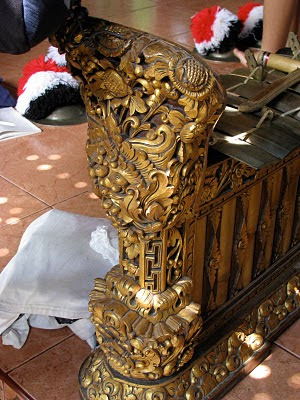Today was our first day of rehearsals for the Summer Institute. We rehearse from 9am-noon and then from 1-4pm. Of course, there are breaks in there and an extended lunch time came to be the norm. There is a concept here which is referred to as "Bali time". This essentially means that things happen when they happen and one should neither expect something to happen when scheduled nor get upset when it doesn't. So, in theory we rehearsed for the times stated above, but in reality we rehearsed when we rehearsed.
Before rehearsal we had to have a prayer ceremony at the Pondok, which was essentially our home base (it was the home of the program directors), as a group asking the gods (Bali, if you weren't aware, is a Hindu island) for their blessing as we began our studies.
 |
| The Pondok |
When the prayer service ended, the musicians in the institute (there were others studying dance) walked to the sanggar (which literally translates as a studio - it's where the gamelan was housed) to begin rehearsals. The "sanggar" was in the housing compound of the Cudamani director, Pak Dewa Berata. In Bali, several related families all live together in one large compound, and share a lot of community space. We were, quite literally, rehearsing within the private home of several families. The space where we rehearsed had walls on three sides with a thatched roof, while the fourth wall looked out into the open air, towards the temple.
 |
| The Sanggar on a rainy day, facing the temple |
We played on a very beautiful gamelan semarandana, which is a new type of gamelan instrument set that combines the tuning systems of two separate gamelans, allowing the performers to play a wider range of old repertoire as well as allowing modern composers to experiment with different modes and modulations which would not have been possible without the inclusion of both tuning systems (don't worry if that didn't make sense. It was just exciting that I got to play one).
 |
| Hand-carved |
 |
| The gongs - the heart of the ensemble |
 |
| Half of the gamelan - reyong along right side of picture |
Day 3:
Much like the previous day, we spent the morning finishing the first piece we were learning. In Bali, music isn't written down as it is in the Western Classical tradition. It is all taught by rote and performed from memory. We were all so lucky to be studying with the Balinese musicians and there were enough of the present that we practically got to study one on one with some of the most accomplished musicians in Bali. I still can't get over how incredible the opportunity was.
After lunch (and I must say, our lunches were delicious! Home cooked Balinese food every single day for lunch. It couldn't have gotten any better than that. I really, really miss the food there.) we had a lesson on kendang, which is the drum played in a gamelan as well as a lesson on reyong.
 |
| Lunch! |
 |
| Kendang |
 |
| Reyong - also see picture from Day 2 for view from above |
More to come!



Wow! All of your photos are so amazingly beautiful. It's so exciting that you were able to have such an experience.
ReplyDeleteThe food does look good...do you know where you might find it in the states?
ReplyDeleteThere is so much in your experience that is just wild, it's hard to take it all in...and that's just from a blog post!
So beautiful and it sounds like such a wonderful learning experience!
ReplyDeleteDoes this mean you'll be trying to recreate some of those dishes? :D
xo
Gorgeous, gorgeous pictures!
ReplyDeleteThose instruments are absolutely stunning! So much detail.
ReplyDeleteLunch looks delicious. Wish I could have been there for that!